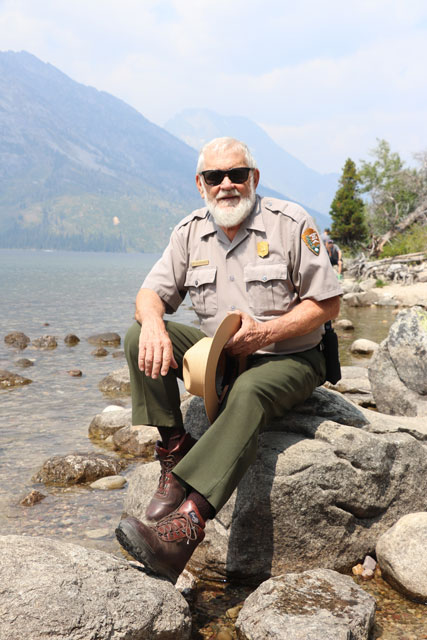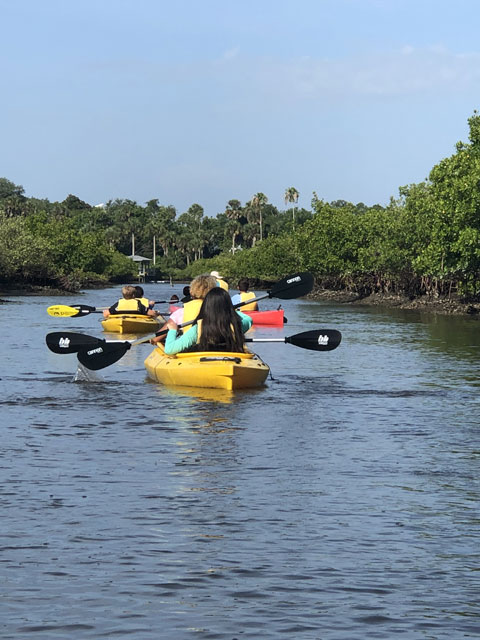Kip Hulvershorn is one of those volunteers who brings a wealth of knowledge and experience to the Marine Discovery Center. He is a retired college professor at the University of Nebraska and a park ranger at Yellowstone National Park and Grand Teton National Park.
These days, you may find him working as a sweep with our kayak guides at MDC. He is featured in our July Volunteer Spotlight with MDC staff writer Lisa Mickey.
Q: Where did you grow up? A: I was raised in Southern Indiana down on the Ohio River.
Q: What is your educational and professional background? A: I went to Indiana University and did my bachelor’s and master’s degrees there. After that, I went to Vietnam for a year with the U.S. Army. After my time in Vietnam, I went into park work in northern Indiana. Then I had an opportunity to go to the University of Nebraska for a job and to complete my doctorate degree. I ended up staying there for 33 years.
When I retired, I ended up spending 10 years at Grand Teton National Park for about five months a year until summer of 2018. I was the lead park ranger based at Jenny Lake [a 423-foot-deep glacial lake], so I had some great years there. Then I decided it was time to retire – to play, have some fun and enjoy our wonderful environment.
Q: What did you teach at Nebraska? A: I taught environmental planning and policy. I was working at the same time and became professor emeritus after 33 years at the University of Nebraska. Most of my summers at Nebraska, I worked in the National Park Service, primarily at Yellowstone. I was a seasonal park ranger.
Q: How long did you spend time bouncing between residences in New Smyrna Beach and Grand Teton National Park? A: About 10 years. My wife Linda and I lived right in the middle of the park. We would stay out there May 1 through the end of September and then come back to Florida. The park never closes, but they don’t plow the roads when the snow gets deep, so it’s only accessible by cross-country skiing. Snowmobiles aren’t allowed.
After I retired, I spent a year at Everglades National Park, then drove up the east coast and came through New Smyrna Beach. I talked to the folks at Canaveral National Seashore and ended up volunteering there for the next two winters. While we were doing that, I ended up buying a place here about 10 years ago and now it’s our permanent residence. I worked in resource management and did some park history and park management stuff at Canaveral out in the field. I worked out of the Titusville headquarters most of the time, but I was in both Apollo Beach and Playalinda Beach.
Q: Why New Smyrna Beach? A: We wanted to live in a warmer climate and we loved the ocean. We looked on both coasts and when we came here, we saw Canaveral National Seashore and all the different habitats. We’ve been very surprised at how much nature there is in Florida. I think almost one third of this state is preserved. There are a lot of natural areas here.
Q: Was your wife also a park ranger? A: She’s in museum/archives kind of work. When we were in Lincoln, Neb., the Midwest Archeological Center is located there. She worked in curation and archives with them and then when we would go to the park for the summers, she would work in the park doing the same museum/archive work in collection management. She has also done that at Canaveral National Seashore as a volunteer and now volunteers at the New Smyrna Museum of History.
Q: Do you have family here? A: We have five kids scattered all over the country from San Francisco and Nebraska to Texas. We spend time visiting them and catching up. I also have two grandchildren.
Q: Are any of your kids park rangers? A: No, but they spend a lot of time in parks. They all have recently been camping and visiting national parks. They grew up spending summers in national parks. That’s in their blood.
Q: When did you start volunteering at MDC? A: I was down at Canaveral and 10 years ago, I heard about the Florida Master Naturalist Program’s Coastal Systems class. I thought that would be a great way to learn more about this coastal ecosystem. I took the class and thought it was very well done and after that, I started volunteering with MDC’s kayak program.
Q: When you work in a park the size of Grand Teton National Park or Yellowstone, what was your main focus? A: My responsibility was supervisory, so I had 12-15 people who were primarily naturalists leading programs and staffing the visitors’ centers. Parks like that are so complex and there are constant crises going on, ranging from rescues, lost personnel, problems in the camp grounds, lost pets – just all kinds of issues.
The park is about 330,000 acres. Yellowstone is about 2.5 million acres. It’s all about helping folks, but you never know what the day will bring. Every day, we were trying to protect the bears from people as much as the other way around. We also had bison, elk and wolves. We want people to see these animals and to appreciate them, but we don’t want people to put themselves in dangerous situations.
Q: Were you involved with prescribed burns on the park property? A: I actually have a long history with that and I taught some fire ecology. I worked in fire management and fire information at the 1988 fires in Yellowstone National Park [that affected 36 percent of the park]. Fire ecology has been a strong interest of mine along with educating visitors about the fear of fire. I’ve tried to help them understand the ecological importance of fire and why we use prescribed burning.
Q: What makes you want to give your time to volunteer, especially now that you have retired? A: I have a real belief in the mission of the places I get involved with. I believe in what the Marine Discovery Center is accomplishing and how it educates visitors, as well as residents about the importance of preserving this special ecosystem, the Indian River Lagoon, the coast and the entire area. Any little bit I can do to help transmit that message and support the staff in doing that, I’ll get involved.
In addition to Canaveral National Seashore, I’ve volunteered with a local coalition. We have crises in terms of the lagoon’s health and rampant population growth and if we can help folks understand and help make wise decisions, that’s important.
Q: What do you enjoy most about volunteering? A: I think seeing the excitement that guests have about the ecosystem here. Of course, the kayaking is interesting. A lot of people have never been out in a kayak and it’s a different experience for them. I get to see not only their joy, but also their understanding that this is an important resource.
Q: Do you volunteer in other places? A: I still help out some at Canaveral National Seashore. I have helped with interpretation there in the past and probably will again in the future.
Q: Do you have any hobbies? A: Mostly kayaking and I swim every day in a pool. We live beachside and I bike at the beach almost every day, but I also enjoy reading and quiet time. I try to attend planning council and city commission meetings and sometimes put my two cents in.
Q: What excites you the most about helping MDC achieve its mission? A: I think it’s making residents and visitors aware of what a unique resource the Indian River Lagoon is and what the challenges are on that resource. MDC helps the public understand that they also need to be making sound decisions about their own behaviors. People can learn things they can do philanthropically to relieve the situations here. I’m enthralled by the progress that MDC has made and I hope it will continue. It’s always a challenge with nonprofits when you keep growing and expanding, but I hope the center is able to get the support needed, whether it’s through grants, donations or fee income to continue to move forward. I’m always amazed at how much is going on.
Q: Has there been a highlight for you at MDC? A: A lot of it is seeing the growth at the Marine Discovery Center. I remember when the center was housed in the trailers on the North Causeway. I love seeing the many different programs in education for kids and adults, but personally, I just get joy out of seeing individual visitors have that ah-ha experience out there on the water.
Q: You have a unique perspective as an MDC volunteer, having worked as a resource manager, a professor, and in the National Park system in some large parks. MDC is a small place in a small town. What’s important for people to understand about where we live? A: We’re trying to maintain a small-town quality and charm while also caring for our resources. I’m always amazed there are so many people who have no idea about the national seashore or all the state and public lands here or the importance of the Indian River Lagoon ecosystem. It’s not just about our beach-town ambience, but also about our unique natural environment.
Q: After working in a variety of different ecosystems, what do you see as our biggest challenge? A: Primarily water quality, and we have some monumental hurdles. The whole septic tank challenge is unbelievable, along with the amount of money it’s going to take and the resources required to fix it. A lot of residents, as well as a lot of elected officials, are not fully educated on that. The issue of uncontrolled, rampant growth is also key. We’re going to have growth, but it needs to be managed and planned much more carefully. We’ve gotten ourselves into a real jam here because growth has stripped both the environmental analyses and our infrastructure needs. The issue of grass and lawn maintenance is another matter. It’s sometimes hard to get people to consider other options using native coastal plants as opposed to [high-maintenance] turf.
Q: You’ve lived and worked in Great Teton National Park. What’s the most fun thing for you to live in a tiny place like New Smyrna Beach? A: That ocean out there. Both Linda and I get out there almost every day for biking and walking. We go out and stroll by the ocean and never tire of it. I just love to see dolphins and creatures on the shore, the changing tides, the dunes, the sand, the whole thing. That’s why we’re here.




Follow Us!